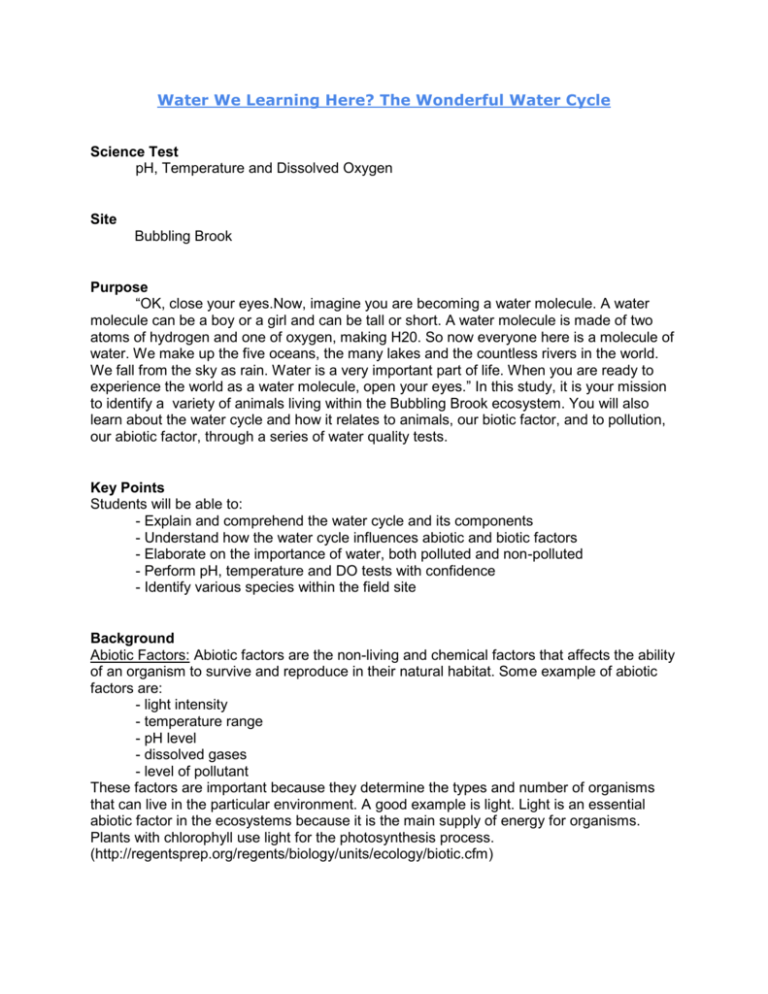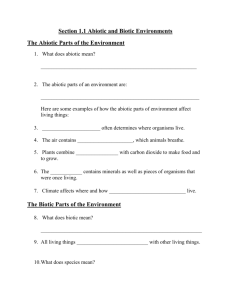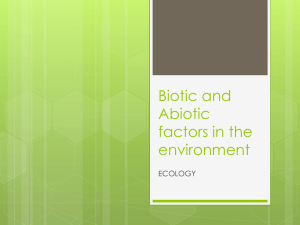File - Tyler Bawden
advertisement

Water We Learning Here? The Wonderful Water Cycle Science Test pH, Temperature and Dissolved Oxygen Site Bubbling Brook Purpose “OK, close your eyes.Now, imagine you are becoming a water molecule. A water molecule can be a boy or a girl and can be tall or short. A water molecule is made of two atoms of hydrogen and one of oxygen, making H20. So now everyone here is a molecule of water. We make up the five oceans, the many lakes and the countless rivers in the world. We fall from the sky as rain. Water is a very important part of life. When you are ready to experience the world as a water molecule, open your eyes.” In this study, it is your mission to identify a variety of animals living within the Bubbling Brook ecosystem. You will also learn about the water cycle and how it relates to animals, our biotic factor, and to pollution, our abiotic factor, through a series of water quality tests. Key Points Students will be able to: - Explain and comprehend the water cycle and its components - Understand how the water cycle influences abiotic and biotic factors - Elaborate on the importance of water, both polluted and non-polluted - Perform pH, temperature and DO tests with confidence - Identify various species within the field site Background Abiotic Factors: Abiotic factors are the non-living and chemical factors that affects the ability of an organism to survive and reproduce in their natural habitat. Some example of abiotic factors are: - light intensity - temperature range - pH level - dissolved gases - level of pollutant These factors are important because they determine the types and number of organisms that can live in the particular environment. A good example is light. Light is an essential abiotic factor in the ecosystems because it is the main supply of energy for organisms. Plants with chlorophyll use light for the photosynthesis process. (http://regentsprep.org/regents/biology/units/ecology/biotic.cfm) Limiting Factors: Limiting factors determine the types and numbers of organisms of a species that can live in an ecosystem. Many limiting factors restrict the growth of species populations. An example of this would be low annual average temperature that restricts the growth of trees. Another example is salinity. Many fish species have a very specific salinity tolerance. If the salinity is to change too much, fish can die off because their environment is not suitable for them. (http://www.nhptv.org/natureworks/nwep12a.htm) Biotic Factors: Biotic factors are defined as any living component that has an effect on another organism. All biotic factors require energy and food to ensure growth. Some examples of biotic factors are: - plants - animals - bacteria - fungi - viruses - parasites Biotic factors are important because they shape ecosystems. It is important to note that biotic factors also include human influence. A good example of a biotic interaction is predation. (http://www.biology-online.org/dictionary/Biotic_factors) The Impact of Changing Factors: If a single factor either biotic or abiotic, is changed, a whole ecosystem can be altered. For example, people can change whole environments through farming or irrigating. Although we, as humans, cannot always see what we are doing to the environment, the organisms can feel it. For example, acid rain in some regions has resulted in the decline of fish populations. (http://library.thinkquest.org/) pH: pH scale measures how acidic or basic a substance is, in this case water. pH is measured on a scale that ranges from 0 to 14. A pH of 7 is neutral. A pH less than 7 is acidic, and a pH greater than 7 is basic. Pure water is neutral, with a pH of 7.0. Vinegar and lemon juice are acidic substances and laundry detergents are basic substances. When other substances, such as chemicals, are mixed with water, the water can become either more acidic or basic. This is important when it comes to surface runoff phase of the water cycle. Runoff from agricultural practices and industrial areas produce harsh chemicals that are washed into bodies of water. This can create toxic effects; each species require a specific range of pH, anything above or below can result in an uninhabitable environment and causes many fish kills. In general, freshwater organisms can survive in a pH ranging from 6.0 to 9.0. (http://www.state.ky.us/nrepc/water/wcpph.htm) (http://www.epa.gov/acidrain/measure/ph.html) Temperature: Water temperature is a very important measure of marine ecosystem health. Temperature influences the amount of biological activity and growth that takes place. Temperature is also an important factor in determining what kinds of organisms can live in the given environment. Most aquatic species require a specific range of temperature in which they can survive. When temperatures stray too far, above or below, from the required temperature, species populations begin to decrease. Water temperature is also important when it comes to water chemistry. When chemicals are added to water bodies, depending on the temperature of the water, chemical reactions generally increases at higher temperature. Water with higher temperatures can dissolve minerals more effectively causing a higher electrical conductivity. However, when it comes to gas, such as oxygen, cooler water holds more oxygen. When water gets warmer, it is not able to hold as much oxygen, therefore, there is not enough dissolved oxygen in the water for all of the organisms to survive. Humans are a major contributor to the heating of water. For example, factories use water to cool their machines. Once the water is used, it is extremely hot and in some cases, put back into nature, increasing water temperature. (http://ga.water.usgs.gov/edu/temperature.html) Dissolved Oxygen (DO): DO measures the amount of oxygen dissolved in water. Oxygen can enter water in a variety of ways; it can enter by diffusion from surrounding air, aeration, and as a product of photosynthesis. Dissolved oxygen is vital in order to sustain life and maintain good water quality. As discussed in the temperature section, water temperature can alter the amount of oxygen that is able to be dissolved into the water. This is important, because like most measures of water quality, the marine organisms can only survive within a certain desired range. DO concentrations should not exceed 110 percent. If concentrations are to exceed that percentage, it can be harmful to the marine organisms; they can suffer from “gas bubble disease”. If DO levels are to drop below the 110 percent, organisms are put under great stress. Another factor that can alter DO levels is pollution. (http://www.lenntech.com/why_the_oxygen_dissolved_is_important.htm) Pollution: Pollution is the introduction of contaminants or substances that don’t naturally occur in a given ecosystem that can cause change. There are many forms of pollution: - chemical substances - foreign objects - light - heat - noise - naturally occurring contaminants Pollution is often classified as either point or nonpoint source pollution. Pollution is important when it comes to considering water quality because any form of pollution can greatly alter water quality, which can severely harm aquatic species populations. (http://www.waterpollution.org.uk/) Water cycle: The water cycle is how water moves between the ocean and other bodies of water, the land and the air. The water cycle begins in bodies of water such as oceans, rivers, lakes and ponds. In order for the water to move from this part of the cycle to the next, evaporation and transpiration need to take place. Transpiration is when trees release water into the atmosphere through their leaves. The sun is responsible for causing the water to evaporate; the water turns into water vapor and forms clouds. Within the clouds, the water vapor condenses into water droplets which eventually fall back to earth as rain or snow, this is known as precipitation. Once the water reaches the earth it can either collect directly back into bodies of water, move over the surface of the earth as surface runoff into bodies of water, or infiltrate beneath the ground, as groundwater, back into bodies of water. Once the cycle is completed, it begins again. (http://ga.water.usgs.gov/edu/watercycle.html) Materials: - Incredible Journey game materials - Nets (12) - Small containers (12) - Waders (12) - Field Guides (12) - Magnifying glass (4) - pH test (6) - DO test (6) - Thermometer (6) Lesson Cycle: Intro (10 minutes): The lesson begins with a story about a water molecule traveling through the water cycle. This story is designed to get the children thinking as if they were a water molecule. They are to keep this mindset throughout the entire lesson cycle. This leads into a game called the Incredible Journey. In this game, students act as a water molecule and “travel” through all aspects of the water cycle. Students are to keep track of their journey through the water cycle and record it in their data booklets. Incredible Journey- https://extension.usu.edu/files/publications/publication/NR_WQ_201113.pdf Transition (5 minutes): Children are guided to Bubbling Brook where we will gather at the benches to prepare for the new material. Introduction to New Material (10 minutes): The mentors will instruct on different concepts that are going to be used in the lesson cycle: - Use a poster with Velcro diagram to talk about the water cycle (have students come up to put the diagram together). We will discuss in detail each part of the water cycle. - Using a poster with diagrams, we will discuss the different tests (pH, DO, and temperature) that we will be doing in the field study. We will also talk about why these aspects of water quality are important for in an ecosystem. - Discuss how to identify the various animals in this habitat using a field guide. - Discuss the differences between biotic and abiotic factors and their importance in this ecosystem. - Explain what we will be doing at each rotation Students will be strictly observing and listening to the material so they can use this information to answer future questions in their data booklets. Split into groups for independent practice (20 minutes for each rotation): Students are split into two smaller groups (counting off by 2’s); one group will go to Station 1 and the others will go to Station 2. Station 1 will have two mentors and Station 2 will have one mentor. At Station 1, students will be concentrating on testing water quality (abiotic factors). At Station 2, students will be concentrating on finding and identifying a variety of species (biotic factors) observed in Bubbling Brook. Station 1: Water Quality Students will be learning how to test water quality through a variety of tests (pH, DO and temperature). The mentor will go over how to perform each test. Students will get into pairs and perform the tests to test the water quality at Bubbling Brook. The overall goal of this station is to assess the water quality of Bubbling Brook and determine if the water quality is good or not. Once all students are done performing their tests, we will gather and discuss the students findings and why they are important. Using the data they collect, they will be able to answer a series of questions in their data booklets (is the water quality good? what factors may change the quality of the water? how do all of these tests work with one another? do they all say the same thing about the water quality?). This activity shows and reinforces how important water quality is and how different factors can alter water quality and the lives of the organisms living in this specific ecosystem. Station 2: Animal Identification Students will have the chance to explore in and around Bubbling Brook. The mentor will begin by going over the rules and handing out materials. Students will then go out and catch any organism they can find in the brook. The students will have to use field guides to identify each animal that they find and record their findings in their data booklets. The goal of this station is to give the students the chance to explore their natural environment and learning about the biotic factors that live in this area. Closing/Discussion (20 minutes): Discuss findings, students will be able to tell us what they learned about the various biotic and abiotic factors within the field site. We will relate the information from the animal identification and the water quality tests to the ecosystem as a whole. We will also discuss the role and effects of the different biotic and abiotic factors on a marine ecosystem. Any extra time we will use to discuss the concepts in greater detail and finish filling out the data booklets. At the end we will discuss a word to add to the groups journey stick. Transition (5 minutes): Students will be guided back to the Environmental Education Center from Bubbling Brook. Assessment: - How well students answer the questions during the closing/discussion and in their data booklets - How much students participate - The types of questions the students ask during the activities








